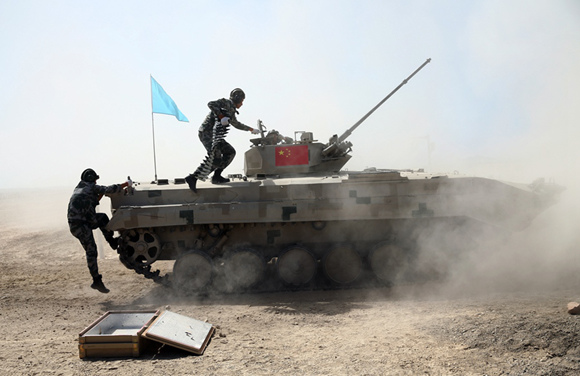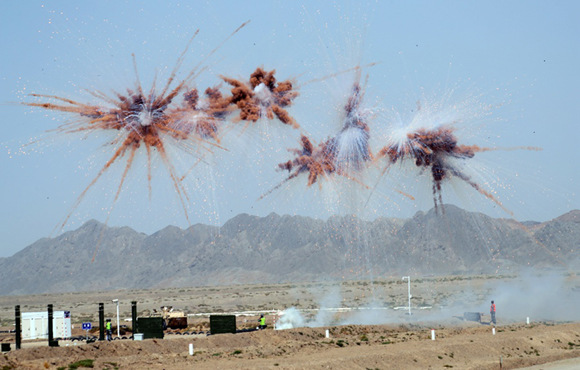
Soldiers load ammunition onto a tank on Aug 4 during the International Army Games 2017 in Korla, Xinjiang Uygur autonomous region. (ZOU HONG/CHINA DAILY)
Lu Donghua carefully lifted the QW-2 antiaircraft missile launcher to his shoulder, drew a breath, and then pulled the trigger. Within seconds, he was watching his target "blossom like a flower" in the sky.
"Just imagine if that target was an attack helicopter sent by the enemy in a real battle," the 26-year-old private with the People's Liberation Army Ground Force said shortly after jumping down from atop a 92A infantry fighting vehicle.
The target was in fact a large circular board about 1.5 kilometers away in the Gobi Desert that had been raised 13 meters above the ground to simulate a helicopter strike.
Four days earlier, on Aug 1, Lu had also shredded a moving target in an antimissile exercise to begin his air-defense unit's campaign at the International Army Games 2017 in Korla, a city in the Xinjiang Uygur autonomous region.
The games, known as the Military Olympics, were initiated by Russia in 2014. This year, for the first time, China hosted four sections: Suvorov Attack, Clear Sky, Safe Environment and Gunsmith Master.
Militaries from 10 countries competed under the blazing desert sun from July 31 until Saturday. According to the official results released over the weekend, teams from the PLA Ground Force won 11 contests over the four sections.
Colonel Tan Yingshuai, a spokesman for the PLA Ground Force, said he believes any military that can claim victory in the International Army Games is also likely to succeed on a real battlefield.
Historic opportunity

Like many soldiers who took part, Lu put the success down to China's unprecedented military reform, which has focused largely on improving combat training for the armed forces.
The Central Military Commission unveiled an overall reform plan in July 2015, which was quickly followed by a decision to cut 300,000 troops as well as revamp the command system. The commission, headed by President Xi Jinping, pledged to establish a leaner and more efficient chain of command, reduce the number of noncombatant personnel and departments, and build the PLA into a mighty force capable of winning a modern war.
While the Ground Force may face the hardest task in meeting the troop reduction target, the reform is a historic opportunity, according to Major General Zhang Mingcai, deputy chief of staff for the Ground Force.
"The reform has forced us to be reborn and pushed forward the restructuring process," said Zhang, who was on the judging panel in Korla. "It has greatly helped optimize troop structure and improve weaponry development. Plus, actual combat training has been significantly boosted."
Lu said he has seen obvious changes in training since the reform began. "We now focus on taking down moving targets with live ammunition instead of practicing on fixed targets, as it's a vital skill in actual combat," the gunner said.
Senior Colonel Yang Yong, the Chinese team leader for the Clear Sky event, which tested a military's air defenses, said the window for destroying an airborne missile-or "making it blossom", as gunners say-is between four and six seconds.
"Tough, strict and realistic combat training is the key to winning battles," he said, adding that during air-defense events, teams had to move quickly after firing at each target, which is necessary in a real combat situation to avoid being spotted by the enemy.


















































